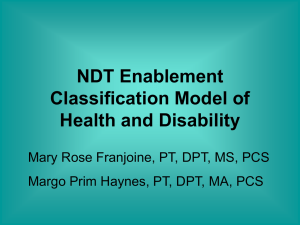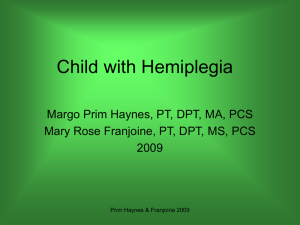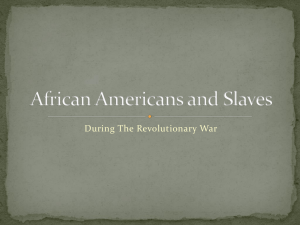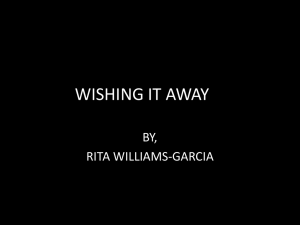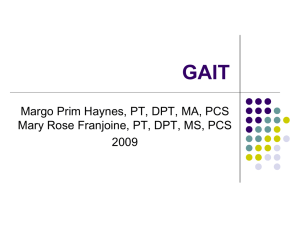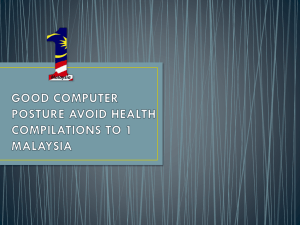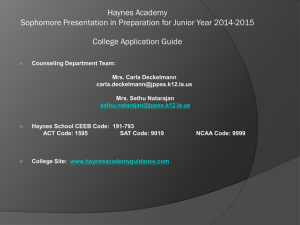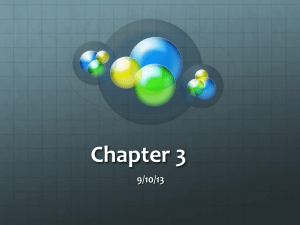Children with Athetosis
advertisement
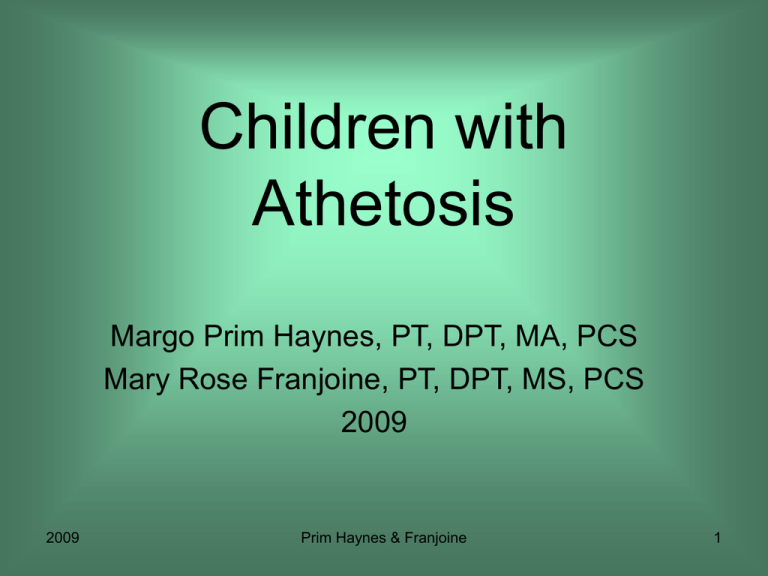
Children with Athetosis Margo Prim Haynes, PT, DPT, MA, PCS Mary Rose Franjoine, PT, DPT, MS, PCS 2009 2009 Prim Haynes & Franjoine 1 2009 Prim Haynes & Franjoine 2 2009 Prim Haynes & Franjoine 3 Role of Basal Ganglia • Associated with a variety of functions: motor control, cognition, emotions, & learning. • Select muscle to work and energizes them appropriately – Helps maintain posture and control automatic movements – Organizes the antagonist & agonist muscles to work together 2009 Prim Haynes & Franjoine 4 General Comments • Children with athetosis have damage to basal ganglia • Holding the body upright against gravity is challenging • Movement appear uncontrolled and involuntary even though client has intent and purpose • Children with athetosis often seen in combination with spasticity & ataxia 2009 Prim Haynes & Franjoine 5 Video of Kevin 2009 Prim Haynes & Franjoine 6 Dimensions NDT Enablement Classification Model of Health and Disability + Domains Dimension Functional Domain Disability Domain A. Body structure & functions Structural & functional integrity Impairments A.Primary B.Secondary B. Motor functions Effective posture & movement Ineffective posture & movement C. Individual functions Functional activities Functional activity limitations D. Social functions Participation Participation restriction From: NDT Approach Theoretical Foundations & Principles of Clinical Practice, Table 2.1 pg. 82 2009 Prim Haynes & Franjoine 7 Body Structure & Body Function • Basal ganglion damage – Damage to Structure: Result of Global Anoxic Event – Interferes with BG ability to function • Select muscle to work and energizes them appropriately 2009 Prim Haynes & Franjoine 8 Cognition Functions: • Motivated to Move - Fearless • Sociable (enjoys being with people) • Intelligence - very bright Impairments • Emotional swings 2009 Prim Haynes & Franjoine 9 Neuromuscular System Impaired Muscle Activation • Co-activation from excessive to minimal (stiffness fluctuates from high to low) during task • Oscillations of trunk, hands and tongue: high amplitude and low frequency 2009 Prim Haynes & Franjoine 10 Neuromuscular System Impaired Muscle Activation • Latency in initiating, sustaining and terminating postural muscle activity • Impaired muscle synergies – Stereotyped patterns of movement simplify demands on CNS 2009 Prim Haynes & Franjoine 11 Neuromuscular System Impairment of Timing and Sequencing • Lack of coordination between agonist and antagonist muscles 2009 Prim Haynes & Franjoine 12 Neuromuscular System Insufficient Force Generation (muscle strength) • Postural Muscles • Movement Muscles 2009 Prim Haynes & Franjoine 13 Sensory System • Sensory Processing Impairment: fluctuates • Visually and auditory aware of environment (fluctuates) 2009 Prim Haynes & Franjoine 14 Musculoskeletal System Secondary Impairments • High risk for scoliosis and hip dislocation • Repeative over use of jaw my led to TMJ problems 2009 Prim Haynes & Franjoine 15 Musculoskeletal System Secondary Impairments • Repetitive asymmetrical movements stress the following joints: – Occiput on C1 – C6 - C7 – T12 - L1 2009 Prim Haynes & Franjoine 16 Dimensions NDT Enablement Classification Model of Health and Disability + Domains Dimension Functional Domain Disability Domain A. Body structure & functions Structural & functional integrity Impairments A.Primary B.Secondary B. Motor functions Effective posture & movement Ineffective posture & movement C. Individual functions Functional activities Functional activity limitations D. Social functions Participation Participation restriction From: NDT Approach Theoretical Foundations & Principles of Clinical Practice, Table 2.1 pg. 82 2009 Prim Haynes & Franjoine 17 Posture and Movement General Characteristics: Posture • Underlying postural tone low with fluctuations • Hyper mobile Joint Structure • Asymmetry = poor midline orientation • Use superior lateral visual fixes 2009 Prim Haynes & Franjoine 18 Posture and Movement General Characteristics: Posture • Alignment: Tend to lock distal extremities into end ranges for stability • Head used consistently for stability • Wide BOS to help stabilize so postural muscles do not have to work 2009 Prim Haynes & Franjoine 19 Posture and Movement General Movement Characteristics • Moves with asymmetrical phasic bursts • Initiates movement with asymmetrical extension • Prefer large amplitude wide range movement (characteristic of fluctuating tone) 2009 Prim Haynes & Franjoine 20 Posture and Movement General Movement Characteristics • Balance insufficient to prevent from falling • Prefers to move in sagittal plane for added stability • 2009 Prim Haynes & Franjoine 21 Prone Postures: • Difficult position for function because of pull of gravity Movement • Equally difficult to initiate movement 2009 Prim Haynes & Franjoine 22 Pictures 2009 Prim Haynes & Franjoine 23 Supine Postures: • An equally difficult position = pull of gravity into the surface Movement • Push off surface with feet and head (asymmetrical) – Pushing in this position often becomes a means of mobility 2009 Prim Haynes & Franjoine 24 Pictures 2009 Prim Haynes & Franjoine 25 Sitting Position • Sitting is an easier position • Independent in W sit – wide BOS Movement • Stabilize with upper body to get lower body mobile 2009 Prim Haynes & Franjoine 26 Pictures 2009 Prim Haynes & Franjoine 27 Mobility in Quadruped Posture: • Alignment: arms internally rotated elbows hyperextend, weight bearing on dorsum of hand Movement: • Bunny hop = pelvis behind knees 2009 Prim Haynes & Franjoine 28 Pictures 2009 Prim Haynes & Franjoine 29 Kneeling Posture • Hips in increased flexion and abduction supporting the wide BOS (pelvis posterior) Movement • Stabilize with upper body to move 2009 Prim Haynes & Franjoine 30 Standing & Walking Postures • Often a difficult posture to maintain. • Uses end ranges in LE to assist with stability. Movement • Weight shift by rotating the head and jaw to obtain extension 2009 Prim Haynes & Franjoine 31 Pictures 2009 Prim Haynes & Franjoine 32 Oral-Motor Skills • Mouth used for stability • “Fixes” with the jaw, severely limiting articulation • May grind the teeth • Drooling 2009 Prim Haynes & Franjoine 33 Video 2009 Prim Haynes & Franjoine 34 Dimensions NDT Enablement Classification Model of Health and Disability + Domains Dimension Functional Domain Disability Domain A. Body structure & functions Structural & functional integrity Impairments A.Primary B.Secondary B. Motor functions Effective posture & movement Ineffective posture & movement C. Individual functions Functional activities Functional activity limitations D. Social functions Participation Participation restriction From: NDT Approach Theoretical Foundations & Principles of Clinical Practice, Table 2.1 pg. 82 2009 Prim Haynes & Franjoine 35 Activities & Activities Limitation Locomotor Skills Communicates Basic ADL’s Feeding 2009 May or May not require assistance & AT Requires AT Full time assistance & AT Possible feeding tube as transition to adult Prim Haynes & Franjoine 36 Dimensions NDT Enablement Classification Model of Health and Disability + Domains Dimension Functional Domain Disability Domain A. Body structure & functions Structural & functional integrity Impairments A.Primary B.Secondary B. Motor functions Effective posture & movement Ineffective posture & movement C. Individual functions Functional activities Functional activity limitations D. Social functions Participation Participation restriction From: NDT Approach Theoretical Foundations & Principles of Clinical Practice, Table 2.1 pg. 82 2009 Prim Haynes & Franjoine 37 Participation • Due to cognitive ability have potential to go to college and hold down a job. • Our role “dream big” – Think Mobility Equipment & AC 2009 Prim Haynes & Franjoine 38 Treatment Strategies • Focus on active BOS: align from wide to narrow • Postural system must be “awakened” • Strengthen in midranges and end ranges but emphasize work in midranges • Emphasize diagonal and rotational postures and movement 2009 Prim Haynes & Franjoine 39 Treatment Comments 1. Treat up against gravity 2. Creative play allows for smoother transitions and action 3. Be careful with mobile surfaces but make sure that they move 2009 Prim Haynes & Franjoine 40 Children with Athetosis 2009 Prim Haynes & Franjoine 41

